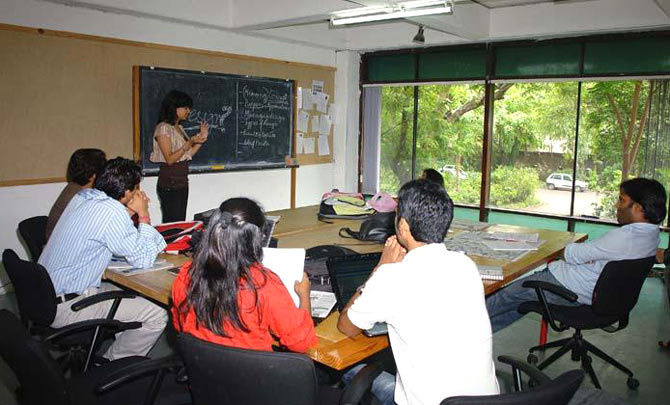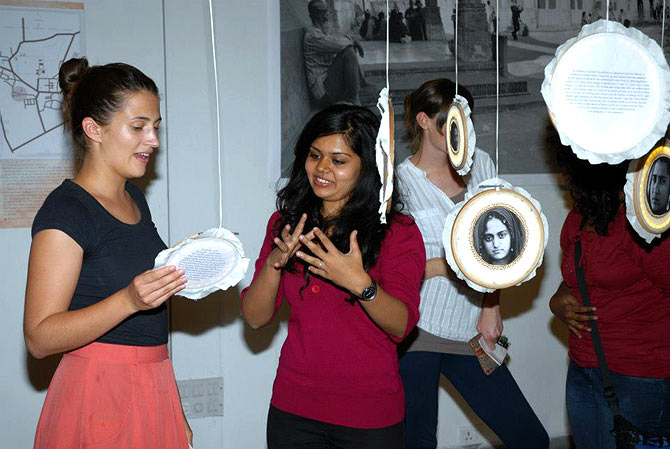 | « Back to article | Print this article |
Career advice: How to become a design manager
In India, there is an increasing demand for management professionals who have a keen sense of design and can interpret it to develop businesses around it. Find out how you can pursue a career in design management and what are your prospects in it
As design becomes an important function across industries, a need has emerged for managers and leaders who understand the nuances of design.
Professionals play a key role in managing design firms, projects and design teams, as well as heading design strategy and research functions in organisations.
Offered by the best design schools across the world, the two-year programme in design management grooms professionals to play leadership roles in the design domain, and is now gaining prominence in India.
Please click NEXT to continue reading...
Students are taught to view the bigger picture
FAST FACTS
Institutes: NID, Ahmedabad; NIFT; Sushant School of Design (Ansal University), Gurgaon
Programme: 2-2.5 year PG Diploma/M Des in Design Management
Eligibility: Degree in Design, Engineering, Technology, Fine Arts, Architecture, Interior Design/Planning; Diploma in Design (under 10+2+4yr); some programmes accept UG (any discipline)
Job roles: Entrepreneurs; Design Managers/Heads/Strategists, Research Heads for firms/ design departments/designer labels
Beyond designing
"In my personal opinion it makes a lot of sense to have some experience to undergo an SDM kind of generic multidisciplinary programme,” advises Bhavin Kothari Associate Senior Faculty, Coordinator, Strategic Design Management (SDM) at NID.
Sonal Mukhia, an apparel designer from NIFT worked in several apparel houses before joining NIFT’s two-year M Des programme in Design Space.
“I have a research bent to my work, and this course was just what I was looking as it had a research-based approach to design,” shares Sonal, who was placed with Samsung Design India after the course.
Similarly Abhishek Lewis, who wanted to be a fashion designer for the longest time, felt the need to learn about design in a holistic manner.
The NIFT fashion design graduate, who passed out from NIFT’s M Des course, is now Design Head (UXD and Industrial Designer) for Asia, in The Netherlands-based design software company iShopShape.
Understanding business
Unlike UG design programmes where there’s a top focus on learning how to design, this programme includes elements like project management, design thinking, strategies that enable innovation, team management, branding, research and marketing.
In other words, students view the bigger picture, that is, understanding the business reality and the role they can play to be able to participate more effectively.
“I was a Designer before and now I am a Design Researcher and Strategist,” explains Sonal, whose role is to understand why a Samsung product should be made, how it should look, if there’s scope of improvement in the existing products.
“Basically, a user’s perspective to design is what I provide through various studies we keep conducting,” she adds.
The full product cycle
Similarly, NID’s PG Diploma in SDM offered at their exclusive PG campus in Gandhinagar, lays emphasis on the full product cycle -- from concept to the consumer’s experience.
NID alumnus Samina Rahman who passed out of the programme worked on several projects with marketing and branding elements.
This includes identifying a need, designing a product/service, creating a business model and branding and brand communication.
'The course prepares you to identify individual and organisational factors that promote creativity'
Abhishek Lewis who holds a master's degree in Design Space from NIFT is currently working as Design Head (UXD and Industrial Designer) in The Netherlands-based design software company iShopShape.
Here, Lewis shares his career experience and tells us how the course helped him. Read on
What is unique about this course?
The philosophy is that every problem is an opportunity for a creative solution and its goal is to help students identify individual and organisational factors that promote creativity.
It presents design research/methods that will enable you to approach the design of complex programmes, systematically.
How did it enhance your career path?
My perspective towards design has changed; I not only want to be a fashion designer and create spellbinding garments but to capture the area and the field, which is untouched by design.
Tell us about your current role
I am with the Netherlands-based software company, taking care of Asia, for their software Mockshop.
With over 400 customers worldwide, it is a leading 3D merchandising software.
'There is a large emphasis on thinking and doing'
Unconventional approach
Unlike mainstream management programmes, there is a large emphasis on thinking and doing.
Projects and hands-on assignments are a part and parcel of the course.
For instance, Lewis spent five months in Chhattisgarh, Bastar rural villages for his Ethnographic Design Research Project.
“Here I stayed with the tribes of Bastar, and was mesmerised by their tribal art and craft. It helped me understand in depth rural/tribal design/art and lifestyle, and how to promote our Indian hidden/unknown art and culture to the world, and help artisans,” he recalls.
A diverse classroom
This programme is not open only to designers but welcomes students from a range of backgrounds.
This is the norm in India and abroad.
NID accepts those with Degree in Design, Engineering, Technology, Fine Arts, Architecture, Interior Design or Planning, or a Diploma in Design (under 10+2+4yr).
NIFT on the other hand accepts students with a degree from any recognised university or Design diploma from NIFT/NID.
The fee for the programmes starts from Rs 2.5 lakhs and above.
Ansal University’s programme is open to graduates of all backgrounds, as the programme itself has a slightly different USP.
'India needs good managers who can handle teams and processes'
Grooming managers
“While India has many talented and successful designers, they need good managers who can handle teams, processes and aspects like money management,” observes Mike Knowles, Dean, Sushant School of Design.
Hence, the course aims to groom students with a keen interest in design, but who will play managerial roles in design firms/departments and design labels on passing out.
This is also the case with the National Institute of Design.
“We have fairly large proportion of students with non-design background, roughly half of the batch with non-design background. But they would certainly have design bent of mind and interest,” shares Kothari of NID.
Scope of the field
"Design research is the first step towards setting up and maintaining a successful project, be it communications, FMCG, appliances or services,” shares Sonal, who sees a plethora of opportunities as India is a ground, which most players want to explore.
Employment opportunities also include trend predicting and forecasting, design and management of fashion brands, research and development in government and private agencies.
According to Kothari, students of this programme at NID have been placed in companies like Proctor & Gamble, Future Group, Landor Associates, Google, Godrej Innovation Labs, HLL, Erehwon Consulting, O&M, ITC Group, Centre for Knowledge Societies, Titan, Panasoni Global, SEWA, Titan, Louis Vuitton and Idea Spice Design Studio and Yahoo.
Teaching is also an option as well as turning entrepreneurs and running one’s own studios.




